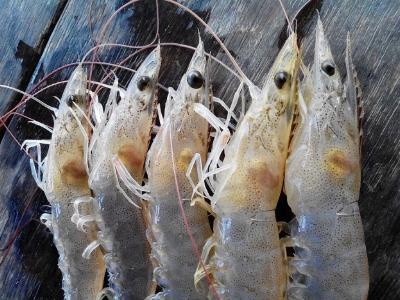Calibrin® -Z Increases Shrimp Survival During Early Mortality Syndrome (EMS) Challenge

Two studies conducted at the University of Arizona showed that shrimp fed Calibrin-Z had survivability of 84% when challenged to induce Early Mortality Syndrome (EMS) vs. 5% for challenged shrimp not fed the enterosorbent, write Ron Cravens, DVM, Fang Chi and San Ching, PhDs.
Background
Calibrin-Z is proven to bind fungal and bacterial toxins and reduce the effects of mycotoxicosis and certain diseases caused by bacterial toxins in poultry. Recently it was found that the cause of EMS in shrimp is due to a toxin produced in the gut by Vibrio parahaemolyticus. Therefore, it was hypothesized that adding Calibrin-Z to shrimp diets would decrease the effects of EMS in shrimp.
Experimental Procedures
Two experiments were conducted at the University of Arizona, Tucson, AZ. A total of 318 specific pathogen free (SPF) Penaeus vannamei at an average weight of 1 gram were stocked for 5 replications (2 reps in trial 1 and 3 reps in trial 2) at 20 or 22 animals per tank into 90 L aquaria.
Overall, five tanks of shrimp were designated as negative control tanks and received no EMS challenge; five tanks served as positive controls, receiving the EMS challenge, but fed a diet without Calibrin-Z; and five tanks of shrimp were fed the diet containing Calibrin-Z and challenged to induce EMS. After a 7 day pre-feeding period EMS challenged groups were fed with diets contaminated with V. parahaemolyticus multiple times (1x/day in Exp.1 and 2x/day in Exp. 2) until the ideal mortality was achieved in the positive control.
The overall survival rate is presented in Figure 1. The accumulated mortality by day is presented in Figure 2.

Water Quality
Water quality was maintained during the experiment as in Table 1.

Histopathology
The cause of the increased mortality from EMS is because of the damage the toxin(s) released by V. parahaemolyticus does to the hepatopancreas of t he sh r i mp. H i s tolog ic a l ex a m i nat ion of representative moribund or surviving shrimp was completed and is summarized in Table 2. Examples of typical histopathology of the hepatopancreas with increasing amounts of damage due to EMS are shown in Figure 3. (Lightner, GOAL 2012).

Conclusions
Challenged shrimp fed Calibrin-Z had:
- Improved Survivability – 84% vs. 5%
- Improved Histopathology – G0 vs. G3




Related news
 Feed Management for Improving Production
Feed Management for Improving Production Feed Management for Improving Production, Economic Returns for the Semi-Intensive Pond Production of Litopenaeus vannamei.
 Beneficial Microbes for the Sustainable Management of Shrimp Aquaculture
Beneficial Microbes for the Sustainable Management of Shrimp Aquaculture Aquaculture production has grown enormously in recent years and among that Penaeid shrimps are one of the most important cultured species worldwide especially
 The Challenge of Shrimp Diseases in Asia
The Challenge of Shrimp Diseases in Asia Aquaculture is one of the fastest growing food-production sectors but the economic impact that parasites and bacterial, fungal and viral diseases